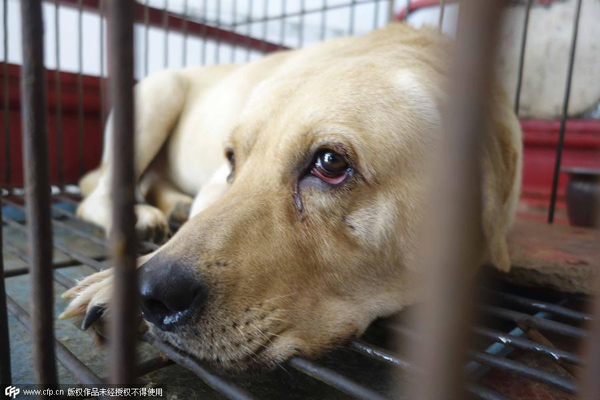Illegal dog meat trade society's common enemy
By Zhang Zhouxiang (China Daily) Updated: 2016-06-20 13:44
 |
|
A dog to be slaughtered in a cage at a dog market in Yulin, Southwest China's Guangxi Zhuang autonomous region on June 19, 2015. [Photo/CFP] |
Despite animal rights organizations' strong opposition, the annual dog meat festival will be held by restaurants in Yulin, Southwestern China's Guangxi Zhuang autonomous region on June 21 this year. Thus we can expect the annual war of words between dog lovers and dog-meat lovers to intensify. Dog lovers say dog-meat lovers are very cruel and uncivilized while the latter say the former are uncivilized, for they lack respect for others' food habits.
In fact, society seems to be divided between dog lovers and dog-meat lovers. But a common enemy could unite them, and that enemy is the illegal dog meat trade chain.
Data show that more than 10,000 dogs are slaughtered every year at the Yulin Dog Meat Festival, but only less than 10 local companies raise dogs for slaughter and none of them more than 100 each. So where do the 9,000 of the dogs slaughtered in Yulin come from?
A 2015 Animals Asia Foundation report, based on a survey of 15 cities in eight Chinese provinces, including Guangxi, found that most of the dogs butchered in Yulin are pets or stray dogs snared by illegal traders.
Pets are almost like family members for owners, who are devastated and traumatized to know their stolen pets have been slaughtered.
For those who have a palate for dog meat, the illegal trade chain is even more detrimental, because it poses a threat to their health. Stolen dogs are definitely not suitable for human consumption, because they are not quarantined. Worse, illegal meat traders always snare dogs with poisonous shots, which could make their meat a big health threat for humans.
In 2014, a man surnamed Yuan and his son had to be admitted to a hospital in Kunshan, East China's Zhejiang province, after eating dog meat, whose source was a stolen pet dog. And similar incidents were reported in Beijing and some other cities in 2015.
In other words, both dog lovers and dog-meat lovers have enough reason to hate the illegal dog meat traders — and it will take the concerted efforts of both groups to curb this illegal profit chain. Dog lovers need to refrain from criticizing those who eat dog meat while those with a taste for dog meat should refuse to buy illegally traded dog meat. This is a point which an increasing number of members from both groups are accepting.
Every year, animal rights activists line up at highway check points to stop trucks that carry dogs to restaurants in Yulin and persuade, even force, the drivers to set the dogs free. This year, too, such activists blocked highway check points, but they let go off the trucks carrying dogs with quarantine permits, and called the police to deal with those carrying stolen dogs instead of enforcing the law themselves. By doing so, they saved 400 dogs in Guangzhou, Southern China's Guangdong province which neighbors Guangxi, on May 29. Their action has been appreciated by many because they not only saved dogs but also protected humans against possible harm.
On the other hand, some restaurants in Yulin serving dog meat have refused to buy stolen dogs and promised only to serve the meat of dogs raised for slaughter.
Zheng Xiaohe, a delegate to the National People's Congress, China's top legislature, impressed the 2016 annual session by presenting an investigative report on the underground dog meat trade chain. His suggestion on how to forbid dog meat trade won wide support even among non-dog-lovers who care about human health offers some food for thought. It is not possible to persuade all dog-meat lovers to not eat dog meat, but at least we can regulate the industry to eliminate illegal dog meat trade, so as to protect dogs and dog-meat lovers and provide some relief for dog lovers.
The author is a writer with China Daily. zhangzhouxiang@chinadaily.com.cn

I’ve lived in China for quite a considerable time including my graduate school years, travelled and worked in a few cities and still choose my destination taking into consideration the density of smog or PM2.5 particulate matter in the region.











